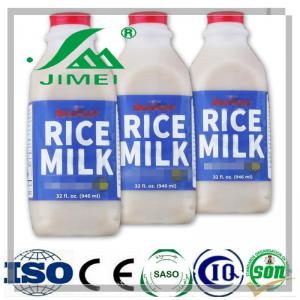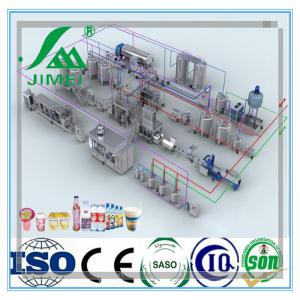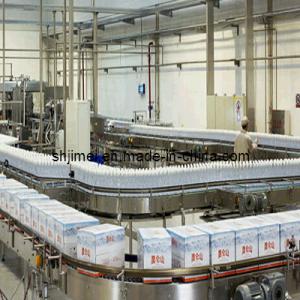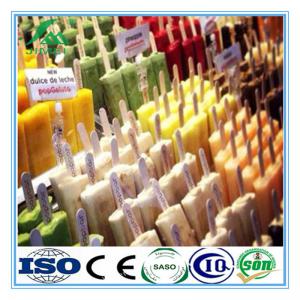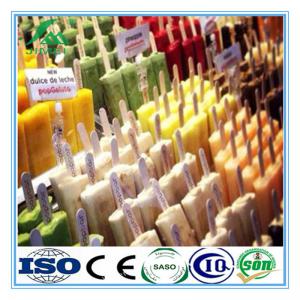Soft drinks are enormously popular beverages consisting primarily of carbonated water, sugar, and flavorings. Nearly 200 nations enjoy the sweet, sparkling soda with an annual consumption of more than 34 billion gallons.
Raw Materials
Carbonated water constitutes up to 94% of a soft drink. Carbon dioxide adds that special sparkle and bite to the beverage and also acts as a mild preservative. Carbon dioxide is an uniquely suitable gas for soft drinks because it is inert, non-toxic, and relatively inexpensive and easy to liquefy.
The second main ingredient is sugar, which makes up 7-12% of a soft drink. Used in either dry or liquid form, sugar adds sweetness and body to the beverage, enhancing the "mouth-feel," an important component for consumer enjoyment of a soft drink. Sugar also balances flavors and acids.
Sugar-free soft drinks stemmed from a sugar scarcity during World War II. Soft drink manufacturers turned to high-intensity sweeteners, mainly saccharin, which was phased out in the 1970s when it was declared a potential carcinogen. Other sugar substitutes were introduced more successfully, notably aspartame, or Nutra-Sweet, which was widely used throughout the 1980s and 1990s for diet soft drinks. Because some high-intensity sweeteners do not provide the desired mouth-feel and aftertaste of sugar, they often are combined with sugar and other sweeteners and flavors to improve the beverage.
The overall flavor of a soft drink depends on an intricate balance of sweetness, tartness, and acidity (pH). Acids add a sharpness to the background taste and enhance the thirst-quenching experience by stimulating saliva flow. The most common acid in soft drinks is citric acid, which has a lemony flavor. Acids also reduce pH levels, mildly preserving the beverage.
Very small quantities of other additives enhance taste, mouth-feel, aroma, and appearance of the beverage. There is an endless range of flavorings; they may be natural, natural identical (chemically synthesized imitations), or artificial (chemically unrelated to natural flavors). Emulsions are added to soft drinks primarily to enhance "eye appeal" by serving as clouding agents. Emulsions are mixtures of liquids that are generally incompatible. They consist of water-based elements, such as gums, pectins, and preservatives; and oil-based liquids, such as flavors, colors, and weighing agents. Saponins enhance the foamy head of certain soft drinks, like cream soda and ginger beer.
To impede the growth of microorganisms and prevent deterioration, preservatives are added to soft drinks. Anti-oxidants, such as BHA and ascorbic acid, maintain color and flavor. Beginning in the 1980s, soft drink manufacturers opted for natural additives in response to increasing health concerns of the public.
The Manufacturing
Process
Clarifying the water
1 The quality of water is crucial to the success of a soft drink. Impurities, such as suspended particles, organic matter, and bacteria, may degrade taste and color. They are generally removed through the traditional process of a series of coagulation, filtration, and chlorination. Coagulation involves mixing a gelatinous precipitate, or floc (ferric sulphate or aluminum sulphate), into the water. The floc absorbs suspended particles, making them larger and more easily trapped by filters. During the clarification process, alkalinity must be adjusted with an addition of lime to reach the desired pH level.

Filtering, sterilizing, and dechlorinating the water
- 2 The clarified water is poured through a sand filter to remove fine particles of floc. The water passes through a layer of sand and courser beds of gravel to capture the particles.
- 3 Sterilization is necessary to destroy bacteria and organic compounds that might spoil the water's taste or color. The water is pumped into a storage tank and is dosed with a small amount of free chlorine. The chlorinated water remains in the storage tank for about two hours until the reaction is complete.
- 4 Next, an activated carbon filter dechlorinates the water and removes residual organic matter, much like the sand filter. A vacuum pump de-aerates the water before it passes into a dosing station.
Mixing the ingredients
- 5 The dissolved sugar and flavor concentrates are pumped into the dosing station in a predetermined sequence according to their compatibility. The ingredients are conveyed into batch tanks where they are carefully mixed; too much agitation can cause unwanted aeration. The syrup may be sterilized while in the tanks, using ultraviolet radiation or flash pasteurization, which involves quickly heating and cooling the mixture. Fruit based syrups generally must be pasteurized.
- 6 The water and syrup are carefully combined by sophisticated machines, called proportioners, which regulate the flow rates and ratios of the liquids. The vessels are pressurized with carbon dioxide to prevent aeration of the mixture.

Carbonating the beverage
- 7 Carbonation is generally added to the finished product, though it may be mixed into the water at an earlier stage. The temperature of the liquid must be carefully controlled since carbon dioxide solubility increases as the liquid temperature decreases. Many carbonators are equipped with their own cooling systems. The amount of carbon dioxide pressure used depends on the type of soft drink. For instance, fruit drinks require far less carbonation than mixer drinks, such as tonics, which are meant to be diluted with other liquids. The beverage is slightly over-pressured with carbon dioxide to facilitate the movement into storage tanks and ultimately to the filler machine.
Filling and packaging
- 8 The finished product is transferred into bottles or cans at extremely high flow rates. The containers are immediately sealed with pressure-resistant closures, either tinplate or steel crowns with corrugated edges, twist offs, or pull tabs.
- 9 Because soft drinks are generally cooled during the manufacturing process, they must be brought to room temperature before labeling to prevent condensation from ruining the labels. This is usually achieved by spraying the containers with warm water and drying them. Labels are then affixed to bottles to provide information about the brand, ingredients, shelf life, and safe use of the product. Most labels are made of paper though some are made of a plastic film. Cans are generally pre-printed with product information before the filling stage.
- 10 Finally, containers are packed into cartons or trays which are then shipped in larger pallets or crates to distributors.

Turn-key system energy drink production line
The whole energy drink production line consists of the following systems:
1. Water treatment system
2. Preparation system
3. Mixing system
4. Sterilizer system
5. Filling and packing system
6. CIP cleaning system
7. After treatment equipments, like conveyor, package or pallet, etc.
8. There are other assistant equipments used such as steam boilers, air compressor, cold water unit, etc.
9. Installation materials for the process pipline, utility pipeline as well as electrical installation are provided.
Filling and packing types can be decided by the customer then designed accordingly.
Our company can design customized energy drink process lines in accordance to the customers' requirements. The production capacity varies from 1000L/h to 10000L/h according to customer's need
Note: Jimei drink production lines can be widely used to produce carbonated drink, soft drink, energy drink, tea drink and so on.


we also produce
| milk production line small milk processing plant mini dairy plant |
| Milk Production Line Milk Production Machine Milk Equipment |
| Milk production line, equipment, milk processing machinery Dairy Processing |
| milk production machinery |
| milk production plant |
| Milk Yogurt Dairy Complete Production Line |
| mini milk pasteurization plant |
| mini milk pasteurizer machine |
| mini milk processing plant |
| pasteurized milk production line |
| Processing Line Type dairy processing line |
| Processing Line Type dairy processing line |
| small milk homogenizer machine price for sale |
| small milk processing plant |
| small milk processing plant/milk processing plant/small milk processing |
| small scale milk processing machine |
| small scale uht milk processing plant |
| Small Scale UHT Milk Processing Plant For Sale |
| small scale UHT milk production line price |
| uht milk plant |
| uht milk processing plant |
our customer wordwild :

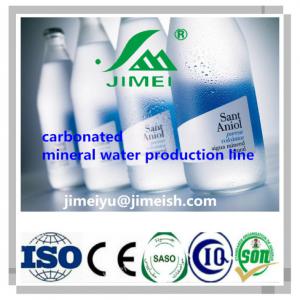
 China
China